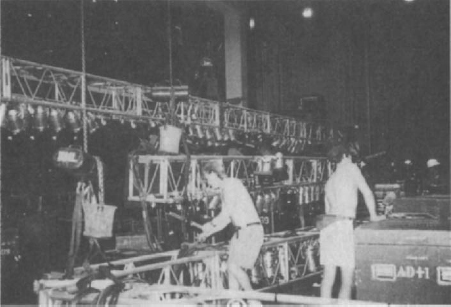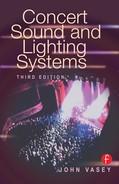CHAPTER 14
TRUSSES AND GRIDS
RIGGING TRUSSES AND GRIDS 
A variety of methods are used to join truss sections: nuts and bolts, pins, and Camlocs. No matter what method is used, check each connection before the truss is lifted (Figure 14–1). The correct position to sling the chain motor is about one-fifth the length of the truss from the end. The length of the truss should be capable of supporting the load suspended without any deflection. Different types of trussing have different load capacities. The longer a truss, the more support it requires. One cannot lengthen a truss and increase the distance between the motors without reducing the load capacity of the truss.
A series of trusses connected together and lifted on several motors is called a grid. The number of motors used on a grid depends on the load. As a rule, support all cross-stage trusses with a pair of motors. Trusses longer than 40 feet may need an additional motor in the center depending on the load. Trusses supported by three motors must have motor tension checked so that the center motor does not end up taking most of the load. The function of the center motor is to provide additional support and reduce the amount of bounce in a truss.
GROUND SUPPORTS 
When no suitable flying facilities are available, ground supports on a solid, level surface must be used. It is dangerous to lift a grid on ground supports because the grid may twist if the supports are not raised together. If the supports are not raised together, one of the supports ends up taking more of the load, which can be disastrous. The heaviest part of a grid is the corner where the cables drop, and this corner becomes heavier the higher it is raised. Trusses supported on ground supports should not be climbed on; focusing should be done from a ladder.

Figure 14–1. Rigging a truss. Various methods are used to join truss sections such as nuts and bolts, pins, and Camlocs.
LIFTING GRIDS 
Before lifting a grid, check all the lamps for tightness and anything attached to the grid for safety (Figure 14–2). The motor controller should clearly identify where the motors are connected. A grid with a large number of looms requires a cable pick to relieve some of its load. When the grid is being raised, the cable pick also should be raised.
Once the grid is at the desired height, it must be leveled. Do not rely on line of sight. Use trim chains or a tape measure for accurate trimming. It is easy to make trim chains with lightweight chain and to tag their length, usually between 18 and 25 feet. Each motor can be adjusted so that the grid ends up perfectly level. If the grid is not leveled correctly, unnecessary strain is placed on the trussing, which can fracture the welding and cause an accident.

Figure 14–2. Raising the grid. Before lifting a grid, check all lamps for tightness and check anything attached to the grid for safety.
